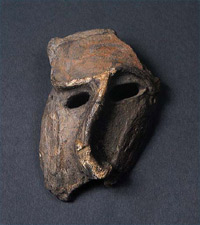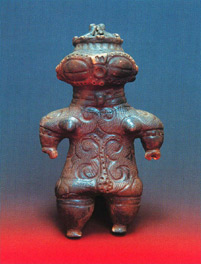The religious relics related to rituals, spells, and religions of the Jomon period are "Jun-ji (earth edition)", "Iwa-jiri (lithograph)", "stone-bar", "Sekito", "stone-crow" and so on. Earthen products represented by clay figurines have concrete expressions and abstract expressions such as poses and facial expressions, and in the latter, in particular, the eyes, mouth, nose, etc. of the face and parts of the body are emphasized or omitted. Make an impression stronger. On the other hand, stone products such as stone rods have the characteristic of polishing stone and making them, but the usage form is an excavated item with many unknown points.
Iwate Prefecture's oldest Dogu is a plate-shaped doctrine excavated from the Suginori site in Nakanoken Ichinoseki City in the early Jomon period (before about 5000 years ago), and it is a small oduji with a total length of 8.7 cm. Although the head and limbs are omitted, it is considered to be a woman because of the chest swelling and waist constriction. There are a large number of clay figurines excavated from the late Jomon period (about 3000 years ago), and 239 clay figurines have been excavated from the Shinzan Gonsha site in Hiraizumi-cho. The basic shape of the earthen is in the form of an inverted triangle, and it is an angry shoulder with shoulders on the long and short legs. In the first half of this period, the face and neck are in front and the clay plate is the core, but in the second half the figure of the neck disappears and the hollow clay figurine in the womb appears, making the human expression rich Become. Furthermore, in the latter half, mouth, ear, and nose-shaped earthen products with a string through hole are also seen, and it is thought that they tied up with a string and formed the face.
The earthen mask is the largest in Japan with a total length of 17.7 cm, and the nose muscle is on the left side of the late Jomon period (before about 2300 years). Because it is crooked, it is called "snoodle". There is a string through hole on the left and right, which is considered to have been used as a mask.
In addition, there is a "shading earthen" as a representative of the late Jomon period (about 2300 years ago). In this clay figure, most of the face is covered with "shading" -like round eyes, and a ring-like nose and mouth are expressed between the eyes. The earthen figurines excavated from the Amasaki waterfall site in Ninohe city are 23.5 centimeters in total length, and the head has a mountain-shaped decoration, face-painting, and represents the late anterior leaf. During the late phase the head becomes crowned, with wider shoulders and waist and larger dimensions. The earthen figurine excavated from the ruins of Teijiro Mori in Morioka city is a large one with a total length of 31 cm. The head, right arm and torso were excavated 60 cm apart. There are cases where other sites are excavated from such a distant place, which is considered to represent a form of disposal after religious events.
Jomon period faith
Updated Date: 2019-03-15


